
Jump to:
Ruby Roman grapes are red, delicious and beautiful — but they’re most famous for their astounding price (some selling for about $10,000 USD a bunch)! These aren’t just any grapes, though. They’re rare — and only grown in Japan. This article will tell you all about Ruby Roman grapes, why they’re so expensive and more.
What Are Ruby Roman Grapes?
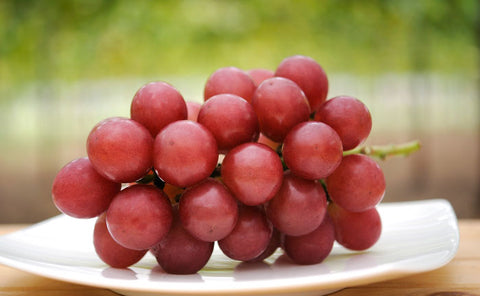
As the name implies, the color of these grapes is red (like a ruby). They are quite large, as well — around 30 mm (about an inch) in diameter. Their flesh is a juicy, translucent gold and green. If you cut one in half, the inside of the grape looks a bit like a kiwi.
Ruby Roman grapes were created in Ishikawa Prefecture (far west of Tokyo) and are a hybrid of two different grape species. According to an article by Ishikawa FOODishbook, “. . . [the grape’s creators] thought to crossbreed large grapes with red grapes, and selected the largest black grapes in Japan, Fujiminori, as the mother grapes.” The exact species of grapes used to make the Ruby Roman is a closely guarded secret, though. The stakeholders in the Ruby Roman market want to keep it that way, too, because rarity is key in keeping up their value.
Where Are Ruby Roman Grapes Grown?
These rare Japanese grapes are grown only in Ishikawa Prefecture. Ishikawa runs along the ocean on the western side of central Honshu Island (Japan's main island). Within Ishikawa, only certain farms are allowed to grow the grapes. According to Ishikawa FOODishbook, they “. . . are now grown in the [Ishikawa] cities of Kaga, Komatsu, Kanazawa, Kahoku and Hakui as well as Hodatsu-shimizu Town.”
A Little History About Ruby Roman Grapes
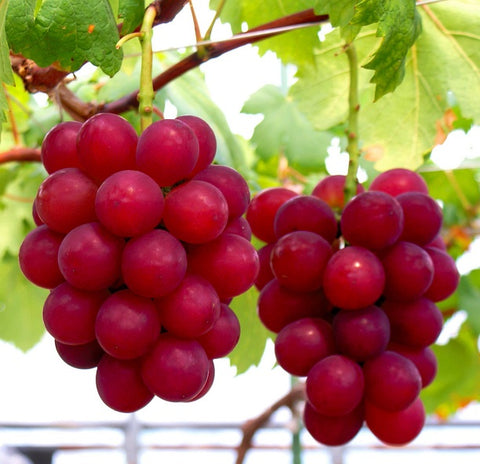
Ruby Roman grapes were discovered when grapevines were planted in soil that (unbeknownst to the farmers) was filled with microscopic rubies. This resulted in a brilliant, jewel-like grape. Okay . . . hopefully you didn’t believe that! Ruby Roman grapes don’t actually involve rubies at all. But they are grapes that were created in Japan, and they do sell for a lot of money.
The story marketers put out about the Ruby Roman implies that consumers really needed a big red grape. Did they? Why not a big orange grape, or a tiny little blue grape? They also imply that some sort of “miracle” took place in their creation (although that is doubtful — it’s just science). The truth is that the Ruby Roman was created by farmers and the local government of Ishikawa as a way to make money — and, fortunately, a delicious fruit, too.
Growing grapes for Ishikawa Prefecture farmers was nothing new — they grew all kinds of grapes before the Ruby Roman came along. They mainly grew Delaware grapes (a small, seedless grape) making up almost 75% of all grape crops. They were also growing the large, black Kyoho grape on a smaller scale. But along the way, they decided they needed something special to set them apart from the rest of the grape market in Japan. Working with the local government, they decided to focus on a new, large grape.
According to an interview with a chief researcher on the project, Hiroshi Isu: “Even though we [were] breeding large grapes, we [couldn’t] differentiate ourselves from other regions by simply producing large, black grapes that [were] already eaten all over the country. Therefore, we decided to develop a variety of large red grapes that were not available anywhere else at the time, and this was the beginning of Ruby Roman.”
So, the farmers experimented with cross-breeding different grape varieties, and it took years to get the match right. There were issues with the grapevine not producing fruit, problems with pollination, and issues with finding the right growing conditions for the grapes to grow. However, after all their trial and effort, they eventually produced the Ruby Roman we know today. It was released to the public in 2008 — very recently!
Why Are Ruby Roman Grapes So Expensive?
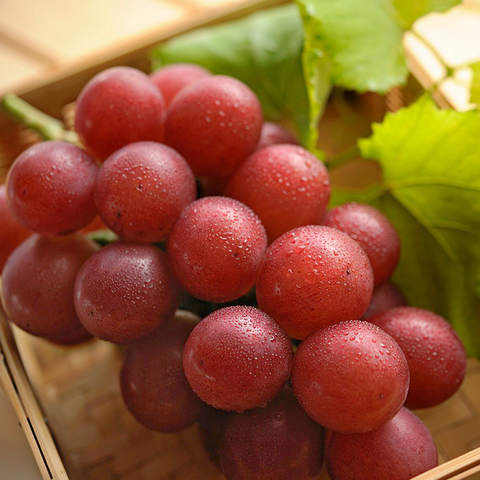
Ruby Roman is one of the most expensive grapes in the world — if not the most expensive. It’s so pricey because it’s rare, labor intensive, and has to meet three strict quality standards to be sold on the market.
It’s rarity is based on the fact that it’s only grown in Ishikawa Prefecture (and only on specific, registered farms). It’s labor intensive because workers focus on making a “perfect” grape — this involves regular trimming, adjusting the lighting, actual re-shaping of the grapes with scissors and more. And as for the quality standards, if the grapes don’t meet them they can’t be sold. The three criteria are:
- Each individual grape must weigh about 20 g (.07 oz) or more.
- Each grape must have 18 degrees Brix of sugar or more. Note: Brix is a measure of sugar, and is explained here — but basically it just means it’s sweet!
- The color of the grapes must match the official color chart. See someone using the color chart in this video.
Note: In researching this article, no one ever mentioned what happened to the grapes that didn’t make the grade. Maybe they’re just made into jelly or something?
How Much Do Ruby Roman Grapes Typically Cost?
Ruby Roman grapes are an unbelievably expensive Japanese fruit — that’s what gets most people curious about them in the first place. According to a 2023 story by Hikkoku Shinbun (a newspaper written where Ruby Romans are grown), “one bunch [of grapes] weighing about 1 kg sold for a record high of 1.6 million yen [around $10,000 USD].” However, those huge prices were only for the highest quality grapes of the harvest season — and those are quite rare (like only a few bunches in the entire harvest).
The “normal” Ruby Roman grapes that we peasants could buy usually go for just under $100 USD per bunch (with some of the higher quality bunches going into the hundreds of dollars). Too poor to buy a whole bunch of grapes? That’s okay, some places sell them individually. An individual grape will cost around $3-10 USD (depending on the quality, store, etc).
Where Can You Find Ruby Roman Grapes?
We know that Ruby Roman grapes can only be found in Japan (where they are exclusively grown), but can you get them overseas? Yes — if you’re willing to pay the price.
Pacific Wild Pick is one company that can get them shipped to you outside of Japan. Just remember that only so many grapes can be produced, so it’s not a guarantee that you’ll get your hands on any. You can make pre-orders, though — probably a good idea.
If you’re in Japan, there are two ways to get these them — in person (at a shop) or by home delivery. Shipping seems to be the way to go as orders of Ruby Roman grapes have increased year over year (see a graph here in Japanese).
To buy online and have them shipped, there are many options. They’ve been listed on sites like Amazon and Rakuten (check for authenticity before buying), but your best bet is online Japanese fruit vendors like Sakaida Fruits.
To buy them in person, you’ll need to go to a specialty Japanese fruit shop that carries them. If you’re in Tokyo it’ll be tough, but a store called Ginza Sembikiya is recommended (check to see if Ruby Romans are in stock before you go).
What Are The Tiers Of Ruby Roman Grapes?
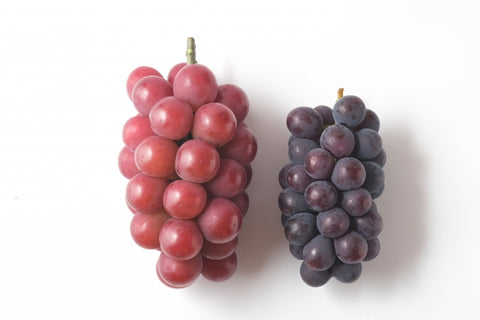
You’ll hear people say there are just two tiers of Ruby Romans — normal and premium. You’ll also hear there are three grades: superior, special superior and premium. Well, they’re all sort of right, but there are actually five grades of quality.
- Superior: Excellent cluster shape, grain weight approximately 20g or more
- Superior G: Excellent cluster shape, grain weight approximately 30g or more
- Special Superior: Excellent bunch quantity and grain uniformity, grain weight approximately 20g or more
- Special Superior G: Excellent bunch amount and grain uniformity, grain weight approximately 30g or more
- Premium: Excellent quality and appearance, all grain weights are 30g or more, and each bunch is 700g or more
The most rare of all is premium, and Yahoo! News explains that “this title is given only to those with particularly excellent color and quality, each grain [individual grape] weighing more than 30 grams and one bunch weighing more than 700 grams. Last year, only 5 of the 22,844 bunches shipped were certified as premium.”
How Are Ruby Roman Grapes Grown?

Ruby Roman grapes are grown in greenhouses only. This is so they can grow in ideal conditions and be monitored closely. Vineyard workers are very careful about the amount of light, moisture and temperature the grapes get. To obtain the perfect color in the grapes (a very important condition in meeting quality standards), they need exactly the right lighting.
They have even developed a smartphone app that calculates the light so farmers can clip leaves above the grapes to adjust the amount of light they receive. You can see all of this in action (and more) on Insider Business’ Ruby Roman YouTube video (filmed at the actual Ruby Roman vineyards).
What Do Ruby Roman Grapes Taste Like?
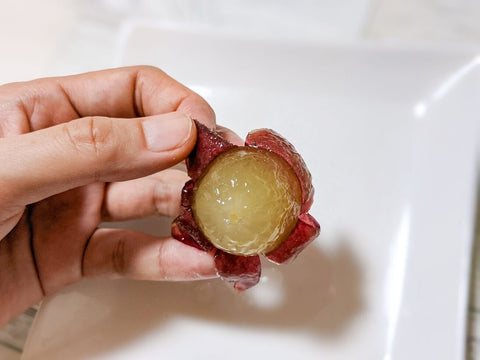
These grapes are sweet, juicy and aromatic. There don’t seem to be any bad reviews about how they taste, actually (you’d better like them after paying that much!). According to a 2020 study on the flavor of the grapes, “The [panelists] used the following terms to describe the taste and aroma sensory attributes of [Ruby Roman] grapes: fruity, floral, green, sour or sweet.”
Sour Grapes: K-Drama
Well, there’s a little bit of an inter-Asia controversy going on with these expensive Japanese grapes. According to The Japan News, South Korea was accused of stealing Japan’s one-of-a-kind vines and selling them in the Korean market under the same name.
The local Japanese government (Ishikawa Prefecture) took this very seriously and investigated. They did some testing and found that the grapes shared the same DNA. This apparently proved that the grapes came directly from the Ishikawa vineyards. At this time, however, Japan doesn’t seem to have any legal recourse because it doesn’t have an international trademark. They’re working on it.
Additional Tips
Here are a couple tidbits of information about Ruby Roman grapes that you might find helpful:
- The grapes are packaged quite carefully to keep them in good shape during shipping and stocking — often sold in boxes with foam padding. Honestly, the package could be a little fancier considering the cost of these grapes, but it’s the fruit that counts, right?
- These grapes aren’t available all year long. Ruby Roman season is only from July to September.
- This is the type of grape that you peel before eating.
Like grape candy more than actual grapes? Try some from Japan here.


0 comments